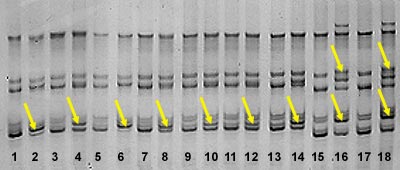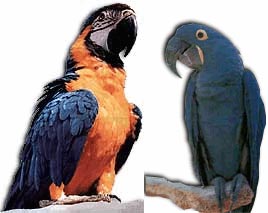SEXING BIRDS THROUGH MOLECULAR TECHNIQUES
|
Description |
Universal sexing birds by molecular techniques, PCR and SSCP-PCR ("Single Strand Conformation Polymorphism- Polymerase Chain Reaction"), through the display of a part of the gene CHD located on the W chromosome and therefore specific to females. Contrary to what happens in mammals where females are homogametic (XX) and males are heterogametic (XY), in birds the pair of sex chromosomes are the same in males (ZZ) and different in females (ZW).

Image of a polyacrylamide gel where are shown, respectively, a male and a female: Imperial Eagle (1, 2); Eagle Owl (3, 4); Peregrine Falcon (5, 6); Stork (7, 8); Yako (9, 10); Amazon parrot (11, 12); Yellow-breasted macaw (13, 14); Partridge (15, 16) and Quail (17, 18). The yellow arrows indicate the specific female bands.
|
How does it work |
From a sample of blood or feathers a conventional DNA extraction is performed, to make later an amplification of a fragment of the first discovered gene on chromosome W, specific of females, CHD (Chromo Helicase DNA Binding Domain). A copy of this gene exists on the Z chromosome and therefore present in both sexes. Contrary to what happens in mammals where females are homogametic (XX) and males are heterogametic (XY), in birds, the sex chromosomes are the same in males (ZZ) and different in females (ZW).
Depending on the chromosomal location of this gene there are differences in its sequence. Therefore, in males, one gene fragment of the Z chromosome is amplified and, in females, two fragments from the Z and W chromosomes, with some variation in the sequence, are amplified. In some species, such variations can be up to 100 bp, so that a simple amplification by PCR and electrophoresis evidence the result. In other species, where the differences are up to 1 nt, the SSCP technique (Single Strand Conformation Polymorphism) is used to demonstrate such variations, differentiating unequivocally both sexes.

Image of an agarose electrophoresis of the PCR amplification of the CHD gene that allows sexing birds.
|
Advantages |

Couple of Macaws.
The joint application of both techniques allows simultaneous sexing of different birds (exotic, raptors ...), thanks to its proven universality.
The molecular techniques have reduced the risk of determining the sex compared with other techniques such as endoscopy, while it has been increased the reliability of the assignment.
At the same time, the quickness of development (two days), and the low price make it ideal for various levels (breeders, individuals or vendors) or objectives such as population studies, conservation, etc.
Another advantage is the possibility of sexing not only from blood but from other samples as feathers or membrane collected in the shell of a recently hatched egg, the last one allows an early sexing.
|
Where has it been developed |
The Genetic Service of the Veterinary Medicine Faculty of Madrid has developed this technique for molecular sexing birds. Since its implantation in 1993 the demand for molecular sexing birds has emerged from: individuals, breeders, importers and different institutions such the Spanish Ornithological Society, indicating the wide range of possibilities.
The technological basis of this Genetic Service is supported by the research that the authors have conducted over the past 20 years and spread through numerous scientific publications in relevant journals, counting also with extensive experience in collaborations with companies and associations. They are part of the group "Animal Nutrigenomics" of the Animal Production Department, Faculty of Veterinary Medicine of the UCM, directed by Susana Dunner. This research group is included in the cluster of Agri-food and Health of the International Excellence Campus (CEI-Moncloa).
|
And also |
The Genetic Serviceof the Veterinary Medicine Faculty of Madrid, offers support to daily veterinary activities (paternity testing, genetic identification,) and to other professionals for other purposes (genetic evaluation, inbreeding rate, estimation of genetic parameters, ...) as in the case of livestock associations (ASEAVA, UCHAE...)
The molecular sexing versatility, thanks to its universality and the advantages mentioned over traditional methods (endoscopy, ...), has expanded its demand not only for breeders, smallholders and sales centers, but that is introduced into recovery of species plans, conservation projects and/or studies of biodiversity, etc., which are becoming increasingly important.
|
Contact |
|
© Office for the Transfer of Research Results – UCM |
|
PDF Downloads |
|
Classification |
|
Responsible Researcher |
Javier Cañón Ferreras: genetica@vet.ucm.es
Department: Animal Production
Faculty: Veterinary Medicine


